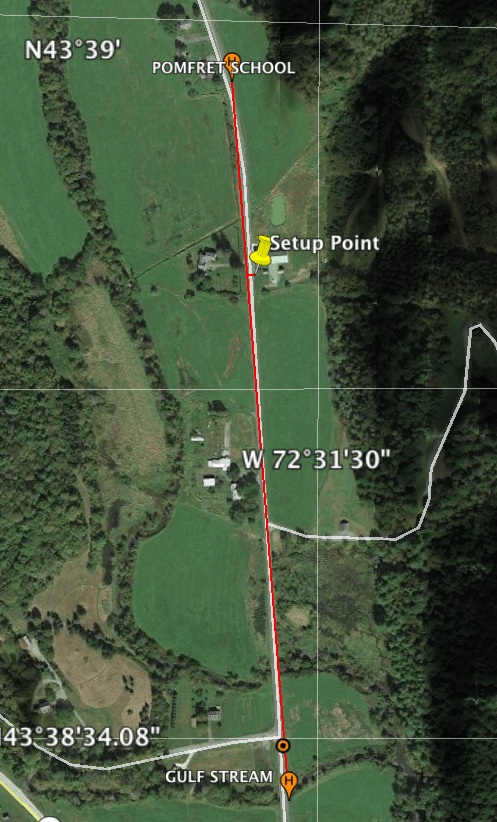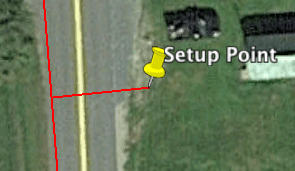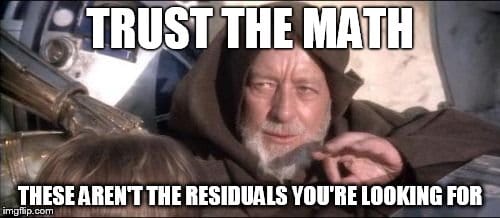Ongoing astro work...Objective is evaluation and perfection of astro technique/capabilities...Have previously setup on the northernmost of two NGS marks. Setup on either mark is not ideal. Northern mark is extremely close to highway and on a 100% slope perpendicular to the line between the marks. Other is on one of the skinniest bridge abutments I've ever laid eyes on. Barely room for a tripod let alone an operator.
There's a very nice spot about a third the way between the two, going south, about 10 meters off the line. Would this "muddy the waters" too much, if I set up there, used the south mark for the back sight, then shot the north mark as well, so long as I take extreme care on the reflector setups? Sun will be approximately 90 degrees to the line. My first thought was to wiggle into the line, but that'd put me in the highway.
Thoughts?
3 cars per day or 300?
Holy Cow, post: 368504, member: 50 wrote: 3 cars per day or 300?
Closer to 300 than 3. The north setup was close enough to feel (and see) instrument shake when vehicles pass (not to mention my butt sticking into the highway). Not hiring a flagman.:excruciating:
I would have absolutely no problem turning angles and calculating the triangle. Some people have issue with the "strength of figure" but I've changed my mind about that issue. Turning a 179å¡ angle is no better or worse than turning a 45 or 60å¡ angle. They're just direction observations. But I would turn multiple sets of angles.
However, I'm not positive exactly what the question is (was it a strength of figure concern?)
Tom Adams, post: 368514, member: 7285 wrote: I would have absolutely no problem turning angles and calculating the triangle. Some people have issue with the "strength of figure" but I've changed my mind about that issue. Turning a 179å¡ angle is no better or worse than turning a 45 or 60å¡ angle. They're just direction observations. But I would turn multiple sets of angles.
However, I'm not positive exactly what the question is (was it a strength of figure concern?)
Just that if you're at one published mark, shooting to another, nothing get's better than that. Given a comfy, safe place to set up, I can turn a dozen sets or more to both points. Running out coffee would be the only limiting factor.
Trust the math.
rfc, post: 368523, member: 8882 wrote: Just that if you're at one published mark, shooting to another, nothing get's better than that. Given a comfy, safe place to set up, I can turn a dozen sets or more to both points. Running out coffee would be the only limiting factor.
I would do the comfy, safe setup, and bring a thermos of coffee. Make sure and don't mix up which is the the backsight and which is the foresight. (That may sound silly, but I've seen it done, and there is not redundancy check).
I don't think a wiggle-in point is any better than doing the off-line point. You are essentially turning a 180å¡ angle by wiggling in, and turning a 175å¡ angle is no worse (in fact, I would say it is the same or better).
There was some discussion a while back where Kent tested resections in Least Squares. And if I recall correctly 180s were the optimal configurations.
With today's equipment, most anything is possible.
You can run a closed traverse using the three points and another if that is what it takes.
The fourth point would give you the opportunity to have a direct measurement in the middle.
:gammon:
Robert Hill, post: 368527, member: 378 wrote: Trust the math.
Do some math first. Put a hypothetical situation into Star*Net and play with the standard errors to get a feel for what is critical.
Observe 6 sets of angles, taking the mean of face 1 and 2 on each. During periods of no traffic.
If your experience is like mine, 2 of the six will be outliers that don't jive with the rest (most commonly the first ones you turn).
Take the sets that do match up, and use the turned angle to solve for your triangle.
If I trust this method for bridge deformation, you can trust it for a high accuracy resection.
Best of luck.
Justin
Bill93, post: 368617, member: 87 wrote: Do some math first. Put a hypothetical situation into Star*Net and play with the standard errors to get a feel for what is critical.
That sounds like a good idea; I know Kent has spoken of doing it before. Unfortunately, I just don't know how to do it. Nada in the manual. Aside from stating the obvious that "what's critical" are error ellipses of the angles to the marks, I'm not sure how to set it up.
Would I leave the sun right out of it; fix the distance and azimuth between the marks (using published data), then assume (but let float) a location for the setup, and estimate the distances to the two marks, and look for the errors in my angles between the two marks?
Classic angle-only resection required angles greater than 30 degrees and less than 150 degrees. Usually used to expand a base net from one tightly-chained baseline. Typically solved with condition equations: triangles have 180 degrees (or spherical excess) etc.
Resections with angles (or directions) + distances = free stations. Generally solved witth observation equations (aka method of indirect observations). 180 degrees is the strongest angle between 2 points when distances are included. Safer & more redundant to do 3 or more free station points as a check against bad control info & as a check against getting the point numbers swapped in a 2 point resection and thinking you are where you aren't.
It's good to know the old caveats from angle-only days. It's good to realize that with least squares and an EDM it becomes like a snickers bar where every measurement gets turned into coordinate peanuts.
Bill93, post: 368617, member: 87 wrote: Do some math first. Put a hypothetical situation into Star*Net and play with the standard errors to get a feel for what is critical.
It seems to be harder than I first expected, but I have an example now.
https://dl.dropboxusercontent.com/u/25124076/Pomfret.dat
You need to enable a block of data to define the problem with the .DATA ON command, and set the parameters of interest, with .DATA OFF for the observational block. Run it in Star*Net.
Then use that output to set values in the observation block along with the standard errors of interest. Then .DATA OFF for the first block and .DATA ON for the second block. You can either do a normal run or a pre-analysis run (pick in the RUN menu) to get statistics, such as for the angle to be turned from the astro object, before considering any error in that angle measurement.
In the output, I only saw 95% confidence for the bearing of interest, so you'll have to back into std err from that. My LS program also gives post-processing std errors.






